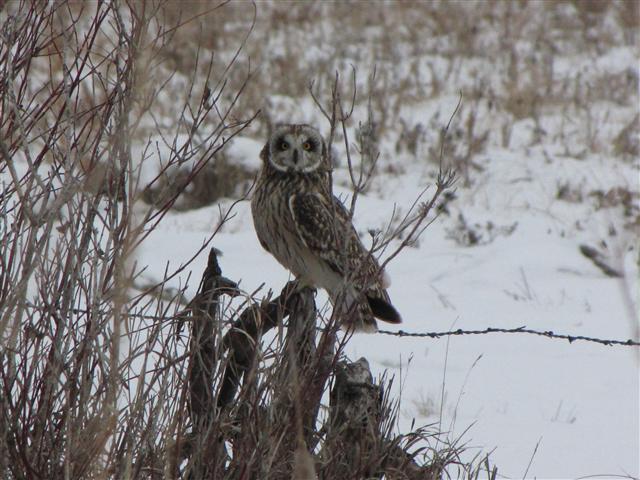Birding by season in Cass and Clay counties
Attached below is a PDF of migration, with estimated arrivals and departures, for a number of area favorites.
Early Spring (mid-March/April/Early May): Greater Prairie Chickens are dancing on leks and continue their activities for the next several weeks. Coveys of Gray Partridge remain evident on city edges until mated pairs begin their secretive nesting activities. As ice leaves rivers and lakes from mid-March to early April, waterfowl start their migration, beginning with the first Canada Geese that wander in from the winter flocks at Fergus Falls. Snow Buntings remain evident, while Lapland Longspurs and Horned Larks increase. Raptor numbers rapidly climb. Bald Eagles are sitting on local nests. Rusty Blackbirds, Eastern Phoebes, Fox Sparrows, and Western Meadowlarks appear. Tundra Swans, Snow Geese, and Sandhill Cranes pass through, sometimes in large numbers. Wilson’s Snipe skulk among the dead cattails, and Killdeer, Baird’s Sandpipers, and other early shorebird migrants arrive.
Late Spring (mid-May to early June): Prairie Chicken leks become less active. Waterfowl numbers remain good but the peak has past. Shorebirds pour through, especially at local waste-water lagoons, harassed by falcons. In riparian woods, Cooper’s Hawks are raising young. Huge numbers of sparrows gradually give way to warblers, vireos, thrushes, and flycatchers. Spring migration winds down, passing birds disappear, locals are nesting.
Mid-Summer (mid-June to mid-July): Birders’ attentions shift to the prairies, including the sloughs and potholes. Felton Prairie’s Grasshopper, LeConte’s, Clay-colored, Lark, Vesper, and Savannah sparrows, Chestnut-collared Longspurs, Loggerhead Shrikes, Greater Prairie Chickens, Wilson’s Phalaropes, Marbled Godwits, and Upland Sandpipers produce their young, and visiting listers search for such occasional species like Nelson’s, Henslow’s, and Baird’s Sparrows, Lark Bunting, Sprague’s Pipit, Say’s Phoebe, and Ferruginous Hawk. At Lake Bertha, Black-crowned Night-herons, Eared, Western, and Red-necked Grebes, and many other waterbirds are nesting while, at appropriate sites, the first returning shorebirds have appeared. Blackbirds and Common Grackles are already flocking.
Late Summer/Early Fall (late July to early September): Late nesters, including American Goldfinches, finally raise their young, while immatures of other species become more evident. Shorebird migration accelerates, with numbers at some lagoons occasionally reaching into the tens of thousands. Songbirds begin a migration which approximately reverses their spring order, but stretching over a longer period. Egrets and herons wander in from breeding areas elsewhere, and waterfowl and gulls begin gathering in flocks.
Mid-fall (mid-September to late October): Shorebird numbers remain high, and raptors, particularly falcons, follow along as in spring. Hawks funnel down the valley corridor, with an occasional flight-day clearly separable from the slighter movements detectable on others. The fall warbler peak is followed by peaks of various sparrow species. American Robins mass in local parks, and swallows flock over sloughs and lagoons before heading south, while impressive numbers of waterfowl pass overhead. Migrating Sandhill Cranes become more evident and often stage in rural areas of the counties. Birders are alert for bizarre rarities, particularly in mid-October.
Late Fall/Early Winter (November and December): Still and moving water freezes and waterfowl numbers eventually plummet, but a few birds linger to the end of the year at the Crystal Sugar Ponds and the Moorhead Sewage Lagoons. Robins slowly diminish to a handful, and sparrow species become scarce, although White-throated, Harris’s, Song Sparrow individuals may overwinter. Northern Shrikes move into the area, the first Snowy Owls (if there are to be any) show up, and we get our first clues about which winter finches (if any) will be invading. Bohemian Waxwings sometimes make an appearance; most raptors leave, but Merlins, Sharp-shinned Hawks, and Bald Eagles usually remain. Flocks of Horned Larks and Lapland Longspurs diminish to be joined and eventually replaced by Snow Buntings. With the Christmas Bird Count over, most birders settle in and become winter feeder-watchers.
Mid-Winter (January): Isolated overwintering birds struggle to survive some of the worst winter storms, and local birders continue to watch for winter finches, Northern Shrikes, Snowy Owls, Short-eared Owls, and previously unreported strays at birdfeeders. Patches of unharvested sunflowers harbor a few concentrations of birds, including Gray Partridge, and sometimes redpolls and blackbirds. Leaking grain bins, deep brush, and evergreen thickets become likely spots for something unusual. Snow Buntings and American Crows may be the only birds findable in open country.
Late Winter (February to early March): Very little has changed, but by early to mid-February, Horned Larks become the first migrants to reappear, and Great Horned Owls and Bald Eagles begin nesting. The first thaw occurs, Lapland Longspurs reappear, and in some years, the rivers open earlier than usual, getting raptors and waterfowl moving before their usual arrival times. By the first week in March, Greater Prairie Chicken leks may host their first dancers.

